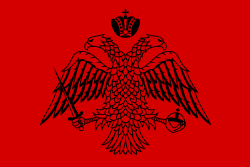Krokodeilos Kladas
Krokodeilos Kladas (Greek: Κροκόδειλος Κλαδάς, 1425–1490[1]), also known as Korkodeilos, Krokondeilos, or Korkondelos, was a Greek military leader, specifically an armatolos, in the Morea (medieval Peloponnese) who fought against the Ottomans on behalf of the Republic of Venice during the latter 15th century.[2][3][4][5]
Biography

Kladas was a member of the prominent Kladas clan. When the Ottoman Sultan Mehmed II (r. 1444–1446 and 1451–1481) took the Morea in 1460, Kladas handed over his castle of Agios Giorgios and was given in exchange the castle of Vardounia in Upper Mani and the territory of Elos.[6] By 1465, the Kladas brothers, Krokodēlos and Epifani, were leading bands of stratioti (warrior bands) on behalf of Venice against the Turks. They put Vardounia and their lands into Venetian possession, for which Epifani then acted as governor. The Kladas brothers were frequently complimented by Venetian officials, and received generous Venetian gifts. Krokodēlos Kladas and his followers stood as rebels against Mehmed, but the Venetian-Ottoman peace settlement, while giving them a full pardon, also returned territorial boundaries to what they had been in 1463, so this put the Venetian-Kladas land holdings back into Ottoman possession. Kladas moved to Venetian-held Koroni.
On October 9, 1480, Kladas led stratioti from Koroni to attack Ottoman holdings in Mani. Both Ottomans and Venetians put a price on his head. This revolt was joined in December by stratioti from Nafplion led by Theodore Bua. An army sent by the Sultan was defeated between Passavas and Oitylo in February 1481. Later that month, a larger force under Mohammed Bey drove Kladas to Porto Kagio where he was taken on board a Neapolitan galley, leaving his revolt to wither in his absence. A peaceful settlement of the revolt was negotiated by the Ottoman governor of the Morea and Venetian official Bartolomeo Minio. Meanwhile, Kladas went with a Neapolitan army to Albania to aid an anti-Ottoman revolt there. It is not known when he returned to Mani. He was captured in battle near Monemvasia in 1490 and flayed alive.[7]
Family
The Kladas family is known in records from the Morea since 1296 when a "Corcondille" managed to capture a Frankish-held castle for the Byzantines.[8] Members of the family made donations to a monastery at Mistra in 1366 and 1375.[9] A Krokodeilos is identified as one of the rebels against the Emperor Manuel II in 1415. The "Crocodile" pun made there is a single appearance and never appears in contemporary documents relating to this Krokodēlos Kladas.[10] The carved inscription on a donation to a church in Karytaina with the name transliterated as"Krokontēlos" is probably not related to him, and the carving is dated to the mid-14th century.[11] He and his brothers are strongly praised in Venetian sources.[12] Kladas had been awarded a Venetian knighthood (and a gold robe) just before the 1480 revolt.[13] Members of the family moved to Kefalonia, and continued to lead stratioti in Venetian service for at least another hundred years.
References
- ↑ Pontificium Institutum Orientalium Studiorum 1992, p. 308.
- ↑ Setton 1978, pp. 328, 551.
- ↑ British School at Athens 1908, p. 162: "This district seems to have been granted by Mohammed II, after the conquest of the Peloponnesus, as a military fief to Krokodeilos Kladas, a Greek guerrilla chief."
- ↑ Cheetham 1981, p. 249: "Among the Greek captains serving under Venetian command was a certain Korkodeilos Kladas, a landowner of sufficient status to have been granted estates in Lakonia when Sultan Mehmet first overran the Peloponnese, as a reward for submitting to the Turks."
- ↑ Merry 2004, "ARMATOLÍ", p. 26.
- ↑ Philippides & Sphrantzes 1980, 40.9.
- ↑ Kladas, p. 11, quoting earlier testimony. Cited in Wright 1999, Appendix 8.
- ↑ Longnon 1949, pp. 803–817.
- ↑ Miklosich & Muller 1865, p. 482; Beēs 1907, pp. 247–248.
- ↑ Mazaris & Seminar Classics 609 1975, 84.12–12.
- ↑ Feissel 1985, pp. 353–354.
- ↑ For examples, see Sathas, Vol. 6, pp. 40–41; Barbarigo, passim.
- ↑ Magno, p. 220.
Sources
- Barbarigo, Iacopo (1466). "Dispacci". 6. Sathas: 1–92.
- Beēs, Nikos A. (1907). "Διοπθωσεις καὶ παρατηρησεις εν Μυστρα μονη τὴς τὴς Παναγίας τοῦ Βροντοχιοῦ". Nea Siōn. 5: 245ff.
- British School at Athens (1908). The Annual of the British School at Athens (Issue 15). MacMillan.
- Cheetham, Nicolas (1981). Mediaeval Greece. New Haven, Connecticut: Yale University Press. ISBN 0-300-10539-8.
- Feissel, Denis; Philippidis-Braat, Anne (1985). "Inventaires en vue d'un recueil des inscriptions historiques de Byzance: III, Inscriptions du Péloponnèse". Travaux et Mémoires. 9: 273–371.
- Kladas, Count Yannis (1872). Ἀρχαία Ἱστόρικα Γεγονότα τὴς Οἰκογενείας τῶν Κομετῶν Κλαδαίων ἀπὸ τὰ 1366 μέχρι 1803. Athens, Greece.
- Longnon, J. (1949). Chronique de Morée: Livre de la conqueste de la princée de l’Amorée, 1204-1305. Paris, France.
- Setton, Kenneth M. (1978). The Papacy and the Levant, Vol. 1. Philadelphia, Pennsylvania: American Philosophical Society. ISBN 978-960-98903-5-9.
- Magno, Stefano. "Ėvénements Historiques en Grèce (1479-1497)". 6. Sathas: 215–243.
- Mazaris; Seminar Classics 609 (1975). Mazaris' Journey to Hades: Or, Interviews with Dead Men about Certain Officials of the Imperial Court. Buffalo, New York: Department of Classics, State University of New York at Buffalo.
- Merry, Bruce (2004). Encyclopedia of Modern Greek Literature. Westport, Connecticut: Greenwood Press. ISBN 978-031-33081-3-0.
- Miklosich, Franz; Müller, Ioseph (1865). Acta et Diplomata Graeca Medii Aevi Sacra et Profana (Volume 1). Vienna, Austria.
- Philippides, Marios; Sphrantzes, George (1980). The Fall of the Byzantine Empire: A Chronicle by George Sphrantzes (1401–1477). Amherst, Massachusetts: The University of Massachusetts Press.
- Pontificium Institutum Orientalium Studiorum (1992). Orientalia Christiana Periodica, Volume 58. Pontificium Institutum Orientalium Studiorum.
- Rankabēs, Eugenios Rizos (1925). "Clada". Livre d'or de la noblesse ionienne (Volume 2). Athens, Greece: Maison d'éditions "Eleftheroudakis". pp. 153–167.
- Sathas, Konstantine N. (1880–1890). Mnēmeia Ellēnikēs Istorias: Documents inédites rélatifs à l’histoire de la Grèce au moyen âge. Paris, France.
- Wright, Diana Gilliland (1999). Bartolomeo Minio: Venetian Administration in 15th-Century Nauplion (Doctoral Dissertation). Washington, District of Columbia: The Catholic University of America.